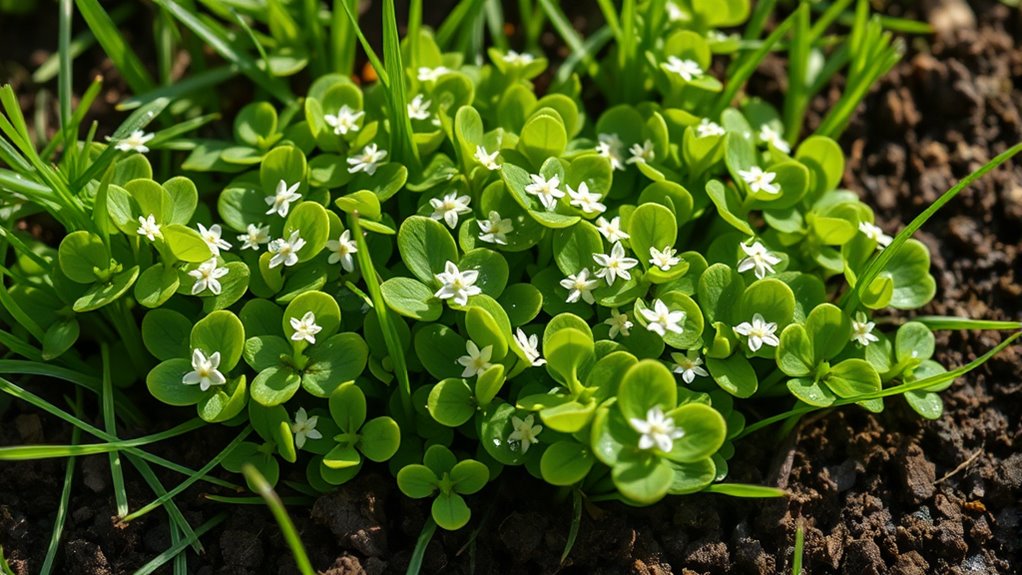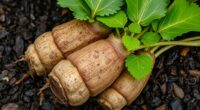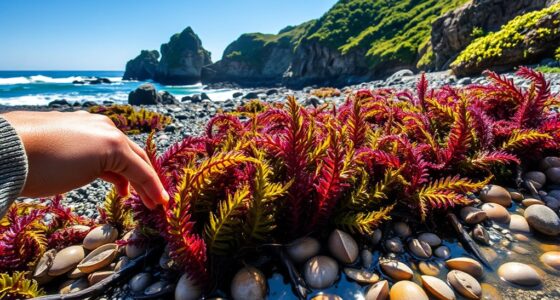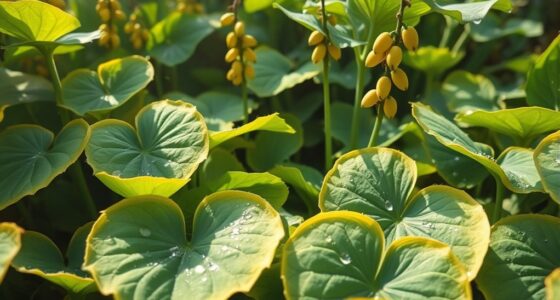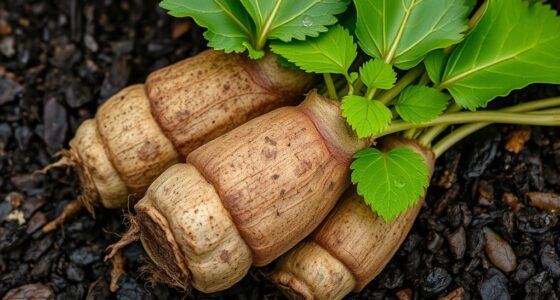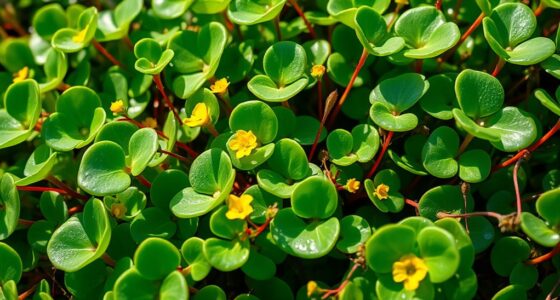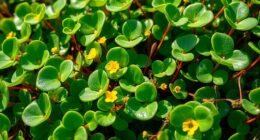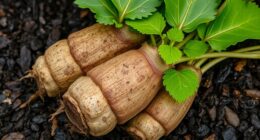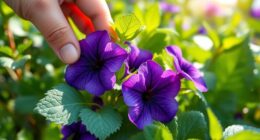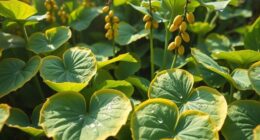To forage chickweed safely, learn to identify its bright green, oval leaves with a single fine hair line along the stem, especially during early spring when it blooms with tiny white star-shaped flowers. Harvest from shaded, moist areas using clean tools, taking only the top 1/4 to 1/3 of the plant. Always verify proper identification and avoid polluted or roadside spots. Keep exploring to discover how to gather and enjoy this nutritious wild green responsibly.
Key Takeaways
- Recognize chickweed by its low-growing, sprawling mats, bright green opposite leaves, and tiny white star-shaped flowers during spring.
- Harvest young, tender chickweed in shaded, moist areas early in the morning for optimal flavor and nutrition.
- Ensure proper plant identification using reliable resources to avoid confusion with look-alikes like scarlet pimpernel or spurge.
- Use clean, sharp scissors to cut the top 1/4 to 1/3 of the plant, promoting regrowth and sustainable harvesting.
- Incorporate chickweed into salads, smoothies, or soups for a nutritious, vitamin-rich addition to your diet.
Recognizing Chickweed in the Wild
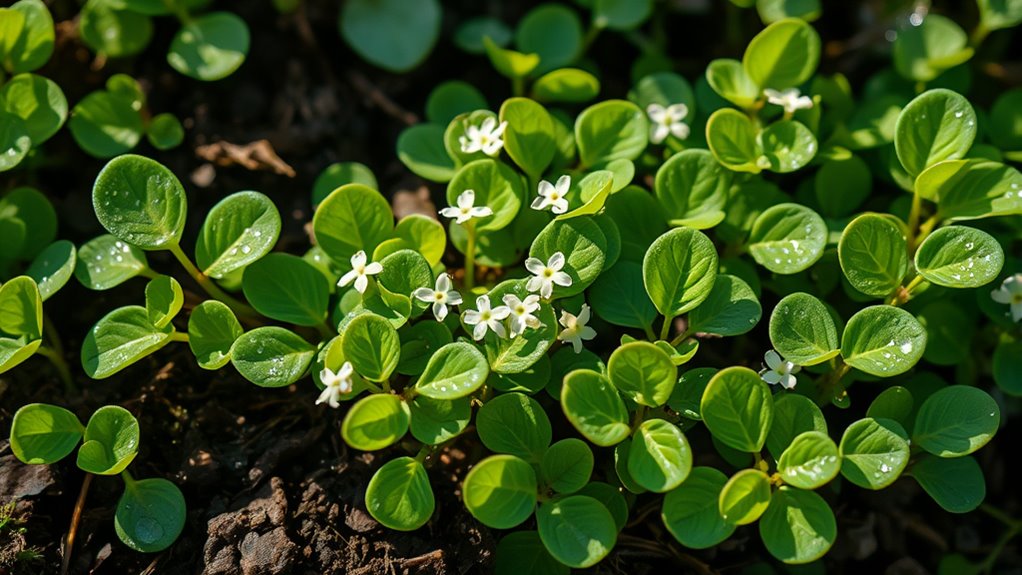
How can you confidently recognize chickweed in the wild? First, look for dense mats of plants with stems reaching up to 9 inches long, sprawling across the ground. The leaves are small, bright green, and grow in opposite pairs, with smooth, oval or lance-shaped margins. Touch the stems; you’ll notice a single line of fine hairs running along one side, which changes direction at stem joints. The plant’s soft, tender leaves and sprawling growth pattern make it easy to spot. During warmer months, tiny star-shaped white flowers with deep notches give the plant away. Be cautious of look-alikes like scarlet pimpernel or spurge, but the key is the single line of hairs on the stem. Wait till it flowers for the clearest identification. Additionally, understanding the nutritional benefits of chickweed can encourage foraging, as it is rich in vitamins and minerals beneficial to health. Recognizing the plant’s growth habits and specific physical features can further aid in accurate identification. Moreover, the color accuracy of the plant’s appearance can vary depending on environmental conditions, making careful observation important. Paying attention to the plant’s growth environment can also help, since chickweed typically favors moist, shady areas and well-drained soils.
Optimal Times and Places to Collect Chickweed
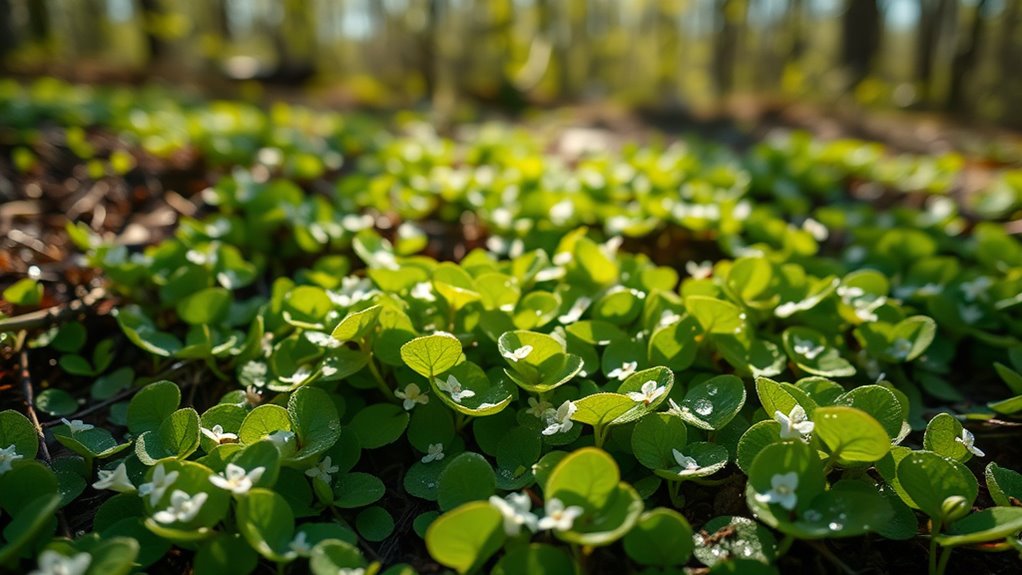
The best times to collect chickweed align with its flowering periods, primarily in early spring when the small white blossoms appear, making it easier to identify. During this time, chickweed is abundant in cool, moist areas like shaded gardens, edges of woods, and meadows. It also grows well in urban lawns, especially in shaded or damp spots. In fall, after summer flowering, chickweed returns in many regions, offering another opportunity for harvesting. In milder climates, it can grow year-round, but summer heat causes it to fade. Cold climates may see chickweed persisting through winter. Focus your collection efforts in shaded, moist locations with nutrient-rich soil. Avoid overly sunny or dry areas, as chickweed prefers indirect light and consistent moisture for *ideal* growth. Understanding chickweed’s growth habits can help you identify the best times and locations for foraging. Additionally, TikTok trends demonstrate that sharing foraging experiences can enhance awareness and community engagement around wild edible plants. Recognizing that chickweed thrives in nutrient-rich soil can further improve your harvesting success. Moreover, paying attention to conservation guidelines ensures sustainable foraging practices that protect local ecosystems. Monitoring environmental conditions can also help determine optimal harvesting periods and prevent overharvesting.
Harvesting Techniques for Fresh Chickweed
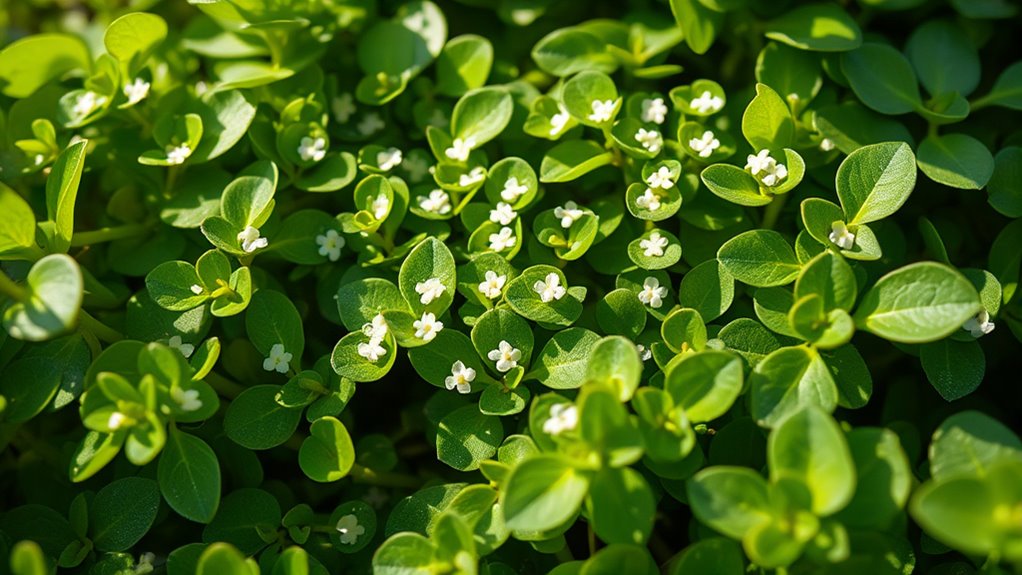
To gather fresh chickweed effectively, you should use clean, sharp scissors or a small knife to cut the plant. Cut the top 1/4 to 1/3 of the plant, about 2-3 inches from the top, to encourage regrowth and maintain sustainability.
Focus on young, tender growth for the best flavor and texture. Harvest during cool, damp conditions, preferably in the early morning when moisture levels are high.
Avoid harvesting during hot or dry weather, which can reduce plant quality. Look for healthy, vibrant green leaves and characteristic white star-shaped flowers.
Target dense patches in shaded, nutrient-rich areas like gardens or woodland edges. Always ensure the area is free of pesticides and chemicals before harvesting.
Incorporating Chickweed Into Your Diet
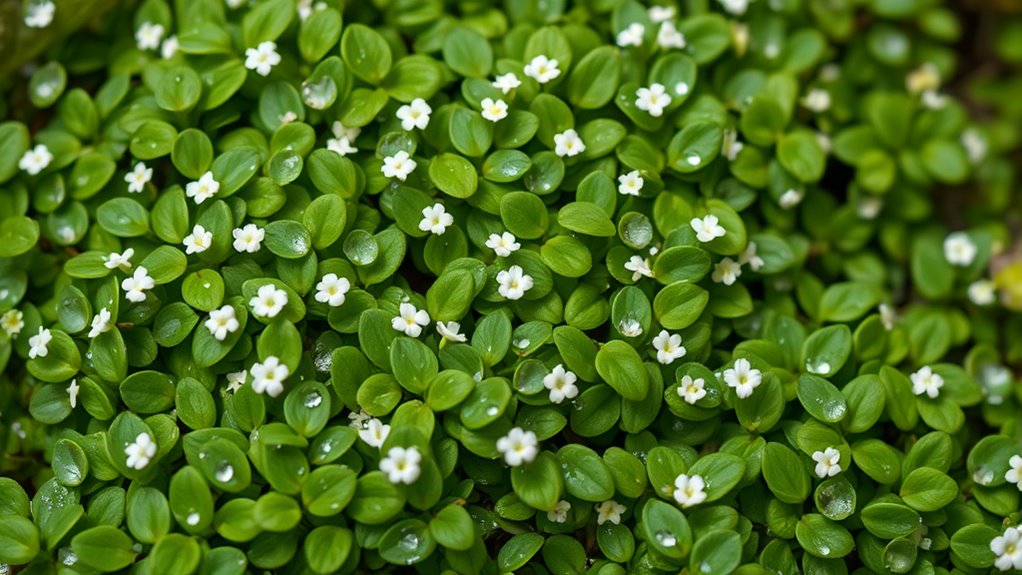
Incorporating chickweed into your diet offers a simple way to boost your nutrition and enjoy its subtle, fresh flavor. You can add it to salads for a nutrient-packed green or blend it into smoothies for an extra boost of vitamins A, C, D, and B complex. Chickweed also works well in soups, adding flavor and fiber, or blended into pesto with garlic, olive oil, and lemon juice. Toss it into sautéed mushrooms or mix it with vegetables like carrots and bell peppers for a colorful stir-fry. Remember to wash chickweed thoroughly to remove dirt and pollutants. Use it fresh for the best flavor and nutritional benefits. Incorporating chickweed regularly can support your immune health, help reduce inflammation, and add variety to your meals. Foraging safety is essential to ensure you identify edible plants correctly and avoid any toxic look-alikes. Additionally, understanding the local ecosystems where chickweed thrives can enhance your foraging success and promote sustainable harvesting practices. Gaining knowledge of edible plants can also increase your confidence when foraging and help you make informed decisions about which plants are safe to consume. Being aware of headphone compatibility with different devices can also improve your listening experience while foraging or preparing meals. Staying informed about best foraging practices can further ensure safe and sustainable harvesting of wild greens like chickweed.
Maintaining a Sustainable Chickweed Patch
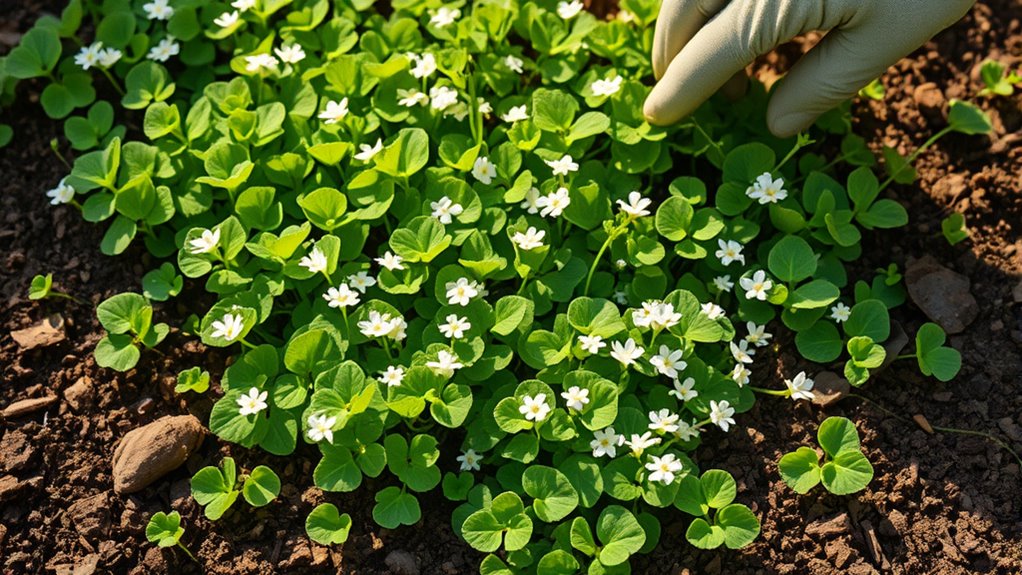
Maintaining a sustainable chickweed patch requires attentive care and environmental awareness. Chickweed thrives in moist soil, especially in areas with poor drainage, and prefers partial shade but can adapt to sun or shade. Regular watering keeps the soil moist and promotes healthy growth, while organic mulch retains moisture and suppresses weeds. Use pruning to encourage new growth and prevent overgrowth, and monitor regularly for pests or diseases. In addition, employing companion planting techniques can help protect against pests and improve soil health. Incorporating biodiversity strategies not only enhances the resilience of your chickweed patch but also promotes a balanced ecosystem. Incorporate cover crops or mulch to reduce weed competition and protect against soil erosion. Adding compost enriches the soil without over-fertilizing. Practice crop rotation and avoid over-harvesting to ensure long-term health. Supporting biodiversity through companion planting and native species enhances soil quality and creates a resilient, thriving chickweed patch.
Safety Tips and Identification Precautions
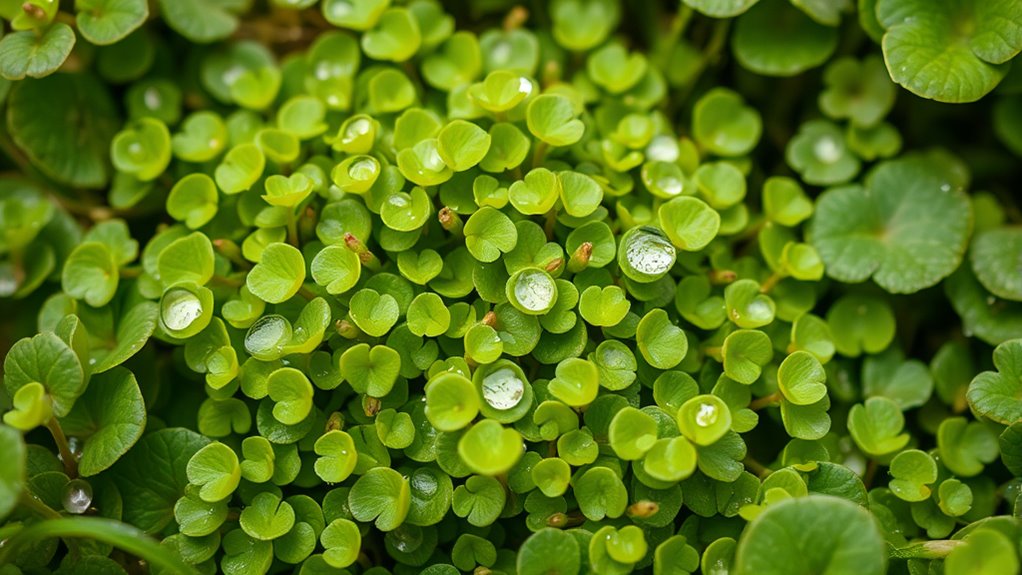
Identifying chickweed safely is essential before harvesting or consuming it, as some plants resemble it closely. Look for stem hairs that resemble a “Mohawk,” a key feature of common chickweed. Check the leaves—they are simple, opposite, and pointed at the tip. The small, white flowers are easy to spot and usually bloom in dense mats or tufts. Additionally, engaging with community engagement can provide valuable insights and confirm proper identification. Be cautious of similar plants like mouse-ear chickweed, which is hairy but differs slightly. Avoid plants with red flowers or reddish leaf undersides, such as the poisonous scarlet pimpernel. Always wash foraged plants thoroughly and ensure proper identification. Incorporating plant identification skills can significantly reduce the risk of mistakes when foraging. Never consume plants if you’re unsure, and avoid gathering near roads or chemically treated areas. When in doubt, consult an expert to prevent potential health risks.
Frequently Asked Questions
Can Chickweed Be Grown Indoors Successfully?
Yes, you can grow chickweed indoors successfully. It thrives with plenty of light, so place your pots near windows or under grow lights.
Use nitrogen-rich soil and water gently to avoid overwatering. Keep the plant in a manageable space, prune regularly, and fertilize with organic options.
With minimal effort, you’ll enjoy fresh greens year-round, and its easy maintenance makes it perfect for indoor gardening.
How Does Chickweed Compare Nutritionally to Other Wild Greens?
Imagine your plate as a treasure chest—chickweed is like a hidden gem among wild greens. Compared to dandelion and dock, it packs a punch with higher fiber, protein, and crucial minerals.
While kale shines with vitamin C, chickweed offers a richer mix of vitamins A, D, K, and essential nutrients like iron, calcium, and selenium. It’s an easy, accessible, and nutrient-dense green to add to your foraging bounty.
Are There Any Specific Pests That Target Chickweed?
You asked if any pests specifically target chickweed. Yes, several pests do, including the Western Tarnished Plant Bug, Lygus Bugs, and Thrips, which use chickweed as a host.
Chickweed also hosts viruses like TSWV and CMV. These pests can damage the plant, spread disease, and compete with crops.
Managing them involves hand-weeding, cultural practices, and biological controls to keep chickweed and nearby plants healthy.
How Long Does Chickweed Stay Edible After Harvest?
You might find that fresh chickweed only stays good for about two days in your fridge, which isn’t long. To make it last longer, you should dry it right after harvesting.
Dried chickweed can be stored in a cool, dry place and used later in teas, salads, or remedies.
Can Chickweed Be Used Medicinally for Specific Health Conditions?
You can use chickweed medicinally for certain health conditions. It’s traditionally believed to reduce inflammation, soothe skin issues like eczema and rashes, and help with pain and swelling.
Its antimicrobial properties make it useful for infections, and it supports digestive health thanks to antioxidants and fiber. However, since scientific evidence is limited, it’s best to consult a healthcare professional before using chickweed for medicinal purposes, especially if you’re pregnant or have allergies.
Conclusion
As you explore foraging chickweed, remember it’s a nutritious spring green that can boost your meals. With over 90% of wild edible plants being safe when properly identified, your chances of enjoying a healthy snack are high—if you follow safety tips. By harvesting responsibly, you help sustain local populations. So, embrace the outdoors, learn the signs, and add this vibrant green to your diet—your body and the environment will thank you.

